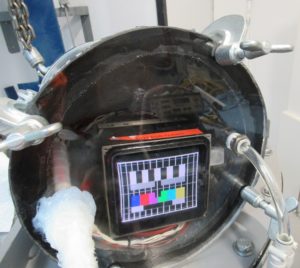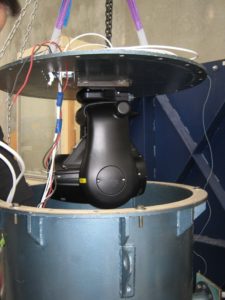Altitude Testing
Altitude testing (i.e. verification of survivability or functionality of equipment when exposed to low air pressure levels) is a mandatory part of the qualification process for any device designed for installation on board air or spacecraft. Alternatively, products unrelated to aerospace applications often require altitude testing in order demonstrate ability to survive stresses occurring during air transport.
Testing involves simulating different stages of flight at required altitude levels using specialised chambers. Typical test profiles may involve of take-off, level flight and landing for non-critical equipment, rapid ascent or descent for most of avionics and explosive decompression for critical equipment.
Austest Laboratories operates altitude testing facilities featuring:

- 6 altitude chambers, up to 4.2 m 3 (4200L)
- Max. altitude of 90,000 ft (2 kPa abs)
- Computerized automatic pressure control
- Pressure cycling
- Rapid decompression
- Explosive decompression
- Combined climatic / altitude testing
Altitude Testing in accordance with defence & commercial standards
Austest Labs is currently the only independent test house in Australia holding formal accreditation for Low Pressure (Altitude) testing in accordance with defence standards such as MIL-STD-810, RTCA DO-160 and DEF STAN 00-35, as well as many commercial ones including:
- MIL-STD-810G
- MIL-STD-202G

Altitude test – Helicopter Searchlight - RTCA DO-160G
- DEF STAN 00-035
- DEF(AUST)5681
- IEC/EN 60068-2-13
- IEC/EN 60068-2-40
- IEC/EN 60068-2-41
- IEC/EN 60068-3-3
- SAE-J1455
- ISTA 2A
- ISTA 3A
- ASTM F2096-11
- ASTM D6653
- EN 50125-3
- AS/NZS 3707
- ST/AG/AC.10/11/Rev. 6
- BS/EN 45502-1

Austest Altitude Chamber – Large
Pressure Testing
In addition to altitude testing, Austest Labs provides high pressure testing services for both gas and liquid mediums. While some of the altitude test chambers and control equipment can be utilised for low-level positive air pressure testing (generally up to 300 kPa a), high level hydrostatic pressure is generally conducted using specialised equipment capable of reaching up to 70 MPa for hydrostatic and 10 MPa for cyclic pressure tests.
Photographs/Videos:



